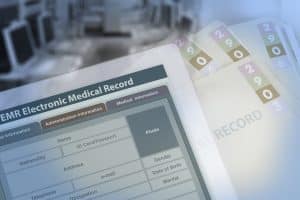Medical billing and coding are essential to the modern healthcare landscape. As more holistic practices are being credentialed by insurance companies, optimizing the medical billing process is essential for success and growth. Unfortunately, many holistic providers may find the medical billing and coding process overwhelming. The good news is that it doesn’t have to be!
These medical billing best practices can help your holistic practice navigate the complexities of the insurance billing process. Follow these tips for the most efficient and streamlined medical billing and coding experience!
What is Medical Billing?
When delivering treatments for any insured patients, medical billing is an essential component in the medical reimbursement process. Medical billing is the process of submitting claims with insurance providers so healthcare providers – whether conventional or holistic – can receive their payments in return for their services to the patient. Any medical provider who is credentialed can be reimbursed by insurance companies for services, including private medical practices, hospitals, outpatient facilities, and holistic practices.
Medical billing ensures that the healthcare provider is being paid for their services by billing both patients and insurance companies so the medical practice can be paid for treatments. Since medical billing ensures medical providers are being paid, any hiccups in the system from denied or delayed claims can negatively affect a practice’s revenue.
What is Medical Coding?
Medical coding is the translating a patient’s medical history of diagnoses and treatments received into a universal, alphanumeric shorthand used by insurance companies to pay medical practices the correct amount for their treatments. Each medical procedure and diagnosis is labeled with a unique code that is used to determine the payment amount.
After a patient’s chart has been translated into the correct code, a billing claim is filed to the patient’s insurance company to request the correct reimbursement for the treatments. During this process, insurance evaluates the claims for accuracy; if there are no errors, then insurance reimburses the medical provider and determines how much the patient owes.
Why Accurate Medical Billing and Coding Is Essential for Holistic Practices
Proper medical billing and coding are key for efficient reimbursement – and successful holistic practice. In general, the financial health of your medical practice weighs on how accurate your medical billing and coding are since consistent errors can be costly.

While every medical specialty needs accurate billing processes to receive payments in return for treatments, holistic practices should take special care of their medical billing. Most holistic practices are smaller than larger medical businesses and therefore have tighter bottom lines. On top of that, holistic practices have unique billing specifications to pay attention to, including regularly changing compliance guidelines and unique uses of modifiers.
Since medical billing is an integral function of the reimbursement process with a direct effect on your holistic practice’s revenue, the more accurate your medical billing is, the more time, energy, and money your practice will have. Instead of spending time resubmitting claims where even the slightest error can delay payments for weeks, accurate medical billing allows you more time to spend doing what you love – delivering care to your patients.
Medical Billing and Coding Best Practices to Implement as a Holistic Provider
As a holistic practice, a streamlined billing process is one of the best ways to boost your revenue cycle management. Here are some medical billing best practices to follow to boost your practice’s financial health and avoid costly errors.
Make Your Medical Billing Statements Patient-Friendly
By making your payments more readily accessible, your billing can be more patient-friendly and easier for patients to make payments so you get reimbursed faster. This includes offering patients a variety of ways to pay for services.
Keep Your Clean Claim Rate Above 95%
The clean claim rate ratio is the average number of claims paid on the first submission. A 95% clean claims rate means that all but 5% of claims get to payers with no errors upon the first submittal. The higher your holistic practice’s clean claim rate, the less time and energy your staff will waste on reviewing denied claims and re-submitting claims. A 95% clean claims rate or higher should be the ideal rate your practice should be aiming towards.
Properly Submit Accurate Claims
One of the most important components of a successful holistic practice is submitting accurate claims the first time. By taking the extra time to review claims for any errors, your practice can avoid wasting time and energy from editing and resubmitting incorrect claims – and the weeks it takes for the delayed reimbursement to finally come through. And, since many holistic practices have a tighter bottom line than other medical practices, maintaining accuracy in your medical billing is essential for increasing revenue.

Stay Up to Date on Medical Billing Rules and Regulations
Medical billing and coding regulations are constantly changing, and this is especially true about billing rules of holistic practices. Medicare is constantly updating its rules for what holistic procedures are covered, and staying informed can create a streamlined process that avoids delays and denies. Your holistic practice’s cash flow can be directly affected if you fail to stay in compliance with current medical billing rules.
Consistently Look For Areas to Improve
Your holistic practice should always be looking for ways to improve. Consistently looking for ways to optimize your medical bolling can identify areas of performance that can help expand your practice. Besides keeping track of regulation changes with medical billing and in your specialty, manage your key performance indicators (KPIs) to monitor the accuracy of past performance to identify areas of improvement or success.
Consider Outsourcing Your Medical Billing
Balancing accurate medical billing and coding with growing your holistic practice can be stressful – and may make delivering care for your patients more difficult. Even if you follow these medical billing best practices, keeping track of changing compliance regulations and ensuring accurate billing may be too overwhelming for your internal team. So, what can you do?
By outsourcing your medical billing to a trusted third party, time and energy is given back to your holistic practice so you can focus on what matters most – delivering care for your patients! Make sure you do your research and choose a medical billing company that specifically works with holistic providers so you can be confident your billing is being handled by experts
Trust Your Insurance Billing to the Holistic Billing Experts!
Leave behind in the past the stress of having to balance your holistic practice’s insurance enrollments, billing, and coding while delivering care to your patients! By choosing to outsource your insurance billing, your holistic practice can streamline your revenue cycle management and handle the responsibility of your medical billing – saving your practice both time and energy you can devote to more important matters such as growing your business and delivering care.
As an experienced billing provider for holistic providers, Holistic Billing Services can help your holistic practice navigate the medical billing process to minimize denials and delays so you can increase revenue. With an expert partner by your side, you can focus more on treating patients to help your practice grow rather than worrying about insurance billing. To learn more about our billing services for holistic providers, talk to one of our billing and coding experts today.
More Americans than ever before are turning away from conventional medicine and embracing holistic healthcare. Whether it’s to alleviate chronic pain, reduce stress, or for other benefits, studies are showing that more people are trading in their conventional doctors for holistic practitioners, or complimenting their conventional care with holistic therapies.
In a survey of more than 89,000 adults and more than 17,000 children, researchers at the National Institutes of Health (NIH) found that nearly one out of three people in the U.S. are seeking holistic healthcare solutions. So, why the shift to holistic medicine? There are several reasons responsible for the ongoing shift towards holistic healthcare.
What is Holistic Medicine?
Holistic healthcare is a form of medicine that treats the “whole person,” treating not the physical self, but also the emotional, spiritual, and mental facets as well. Whereas conventional medicine seeks to provide treatment for pain or the ailment, holistic healthcare focuses on both treatment and prevention. For example, if a patient has an ailment and turns to holistic therapy for help, the holistic practitioner will seek any underlying causes, including the patient’s stress levels and diet.
There are many different types of specialties under the umbrella of holistic medicine, including:

- Massage therapy
- Chiropractic care
- Mental health counseling
- Acupuncture
- Homeopathy
- Nutrition counseling
- Meditation
- Yoga
- Western herbal medicine
By focusing on prevention and health alongside treatment, holistic healthcare has helped millions of people manage their own wellbeing more effectively.
Western Medicine vs Holistic Medicine
Many holistic healthcare specialties have their roots in Eastern medicine. Compared to Western healthcare, Eastern medicine attempts to look at overall imbalances in a person’s life. This focus can be seen throughout all the holistic specialties. There are some key areas where holistic healthcare and Western medicine deviate from one another.
Insurance-Coverage
Until recently, many holistic practitioners were not covered by insurance or were out of network. Even still, many holistic practices may find it harder to be covered by insurance. On the contrary, Western healthcare and treatments are more likely than not covered by insurance providers, and as a result more accessible to Americans.

Cause of Ailment
While Western medicine looks at physical components, such as physical symptoms and genetics, for the causes of illnesses, holistic healthcare looks at the overall wellness of the patient. This includes any possible imbalances, such as issues with mental health and diet. For holistic practitioners, environmental and emotional influences are just as equal factors in the wellbeing of a patient as physical components.
Treatment of Illness
Holistic healthcare also differs from Western healthcare in the diagnosis and treatment of illnesses. In holistic practices, identifying the disease is not as important as in Western medicine because illnesses are viewed as effects of the patient’s individual lifestyle, and so treatments will vary per person and are not as clearly identifiable. Holistic treatments will often incorporate medication, natural solutions or supplements, or diet and exercise regimens. On the other hand, Western treatments will often include formal tests and standard treatments for every patient based on the illness. Treatments often include medication, with suggestions for lifestyle changes.
3 Trends Impacting the Rising Shift to Holistic Medicine
While there isn’t one single reason for the growing popularity of holistic healthcare, there are several trends that may be held responsible for the rising shift of consumers choosing holistic practices.
Growing Skepticism About the Medical Industry
More Americans are growing wary about healthcare institutions and general medical practices. Based on data from an international health care survey, Americans were found to have growing distrust in medical professions. While more than three-fourths of Americans had strong confidence in the medical field in the mid-1960s, currently only 34 percent trust the current medical system. Part of this skepticism can be due to a variety of motives. While many patients have been wary to trust medical research due to the motives being possibly compromised by funding, there is also the perception that key players in the healthcare industry pursue profits at the expense of patients.

There is also a growing public perception that Western medicine may be over-reliant on medications. While people are taking more medications than ever, doctors are also prescribing them on high doses – with some reports indicating that many of these pills are doing more harm than good. While nearly 7 in 10 Americans are taking at least one prescription drug each day, nearly nine in ten (89%) adults 65 and older are on prescription medicine. The most common prescriptions make up antidepressants, antibiotics, and opioid painkillers. One of the attractive aspects of holistic healthcare to many Americans is its lack of medications. For people trying to find less-medicated treatment, holistic medicine seems like a positive solution.
Greater Accessibility
In part due to the growing popularity of holistic medicine, more Western medical practices are adding supplemental holistic care – making it more accessible for patients. Hundreds of healthcare centers, including hospitals affiliated with Duke, Yale, Johns Hopkins, and other top medical research centers, are also offering holistic therapies, including acupuncture, massage therapy, meditation, Chinese herbal therapy, and more. While it’s likely the vast majority of hospitals will have alternative medicine options, this is a far cry from two decades ago when just 14% of hospitals were reported to provide complementary holistic therapies in 2000.
With greater acceptance of holistic therapies in hospitals, clinics, and research centers, more people looking for alternatives are finding them easier to access. While many of these therapies are supplementary and made to complement Western treatments, they are allowing patients access to acupuncture, massage therapy, and even more alternatives.
Wide Range of Ailments Treated
One of the additional driving forces in the growing popularity of holistic healthcare is the wide range of illnesses that alternative therapies can encompass. Since therapies, such as massage and medication, focus less on the exact illness and more on the overall well-being of the patient, people with medical conditions that are not easily treated with conventional medicine are turning to holistic practices for relief.
For patients increasingly dissatisfied with the minimal time they receive with doctors and with physicians who seem to prescribe a pill for every woe, integrating their conventional treatments with holistic therapies or completely choosing a holistic approach to medicine offers a refreshing new take on care.
Prepare Your Holistic Practice for the Future With HBS
With the growing demand for holistic medicine, your holistic practice needs to be optimized to handle growth. Medical billing is especially complicated for holistic practices and can possibly overwhelm your business as you focus on growing your practice and provide care for your patients. By outsourcing your medical billing, you can leave the responsibility of insurance enrollments, credentialing, and medical billing and coding to the experts – saving you time!
As an experienced billing provider for holistic practices, Holistic Billing Services can help your practice navigate the intricacies of insurance billing claims to minimize denials, increase your revenue, and grow your practice. We understand the unique needs of holistic practices, as well as the common obstacles you face when it comes to medical billing and coding. With a knowledgeable partner by your side, you can streamline your billing and increase your revenue cycle management! To learn more about our services, talk to one of our billing and coding experts today.
As a holistic billing company, we focus on integrative health and billing insurance for holistic providers, but we are often asked by our clients for recommendations on how to promote their practice. In our experience, your acupuncture practice can gain new customers and strengthen your current client base with the right marketing.
Learn more about how your holistic practice can develop the most effective acupuncture marketing strategy for overall enhanced revenue cycle management!
Why Marketing Your Acupuncture Process Helps You Stay Competitive and Drive Additional Income

The importance of successfully marketing your acupuncture practice cannot be understated. Even if you have some of the best delivery of care to your patients, your new patient acquisition will be low if you can’t get your name out there! With the right marketing strategy, your acupuncture practice can stay competitive and continually bring in new clients—which means more revenue.
Staying competitive is crucial to driving additional income in an increasingly saturated holistic market. More people than ever before are turning to holistic medicine to maintain and restore their health. The global complementary and alternative medicine market is predicted to have an over 22% growth rate from 2021 to 2028 – eventually reaching over $ 400 billion by 2028. As more and more people turn to holistic medicine, your acupuncture practice must adopt competitive marketing techniques to stand out from the crowd.
Developing a marketing strategy for your holistic practice starts at the basics: delivering the right message. Since more people are turning to holistic medicine to alleviate their back pain and other ailments, cultivating your unique treatment approach that is both authentic to your practice and helps answer the questions clients are looking for will also gain you not only new patient acquisition, but committed clients who keep returning for more.
Acupuncture Marketing Best Practices
In such a growing market saturated with competitors, it may seem difficult to stand out from the crowd. By adopting these best practices, your acupuncture practice can better market to new patients as well as maintain existing relationships with your current client base.
Develop Your Brand
Part of what will set your acupuncture practice apart from the competition is developing your acupuncture clinic’s unique brand. This includes your message style and overall mission statement. You’ll have to address what kind of approach you’ll take to market your practice to the public and what tools you’ll use.
All of this will influence your message tone. For instance, if you’re marketing acupuncture to the elderly, you will use a different tone, style, and content than if you were attracting a millennial client base. Or, let’s say you’re focusing on delivering acupuncture services as an opioid alternative for patients recovering from addiction or surgery. You would use a much different tone of voice in your marketing that speaks to their specific needs than if you were trying to attract a more generic audience.
Grow Your Online Presence
In today’s digital age, building an online presence for your acupuncture practice is a must. This includes an optimized acupuncture website so your business can be easily accessible to those online. A successful website is one where you have the basics, such as your location, contact information, and a bit about who you are and your practice. However, you can add increased value to your website by including what makes your acupuncture practice unique – such as your treatment philosophy, team bios, and FAQs about acupuncture itself.
You also have to make your holistic practice easy to find online as well. Claim your Google business profile so local customers can help locate you in the “acupuncture practice near me” search results. Consider also adding your practice to review sites, such as Google Reviews and Yelp, for customer feedback. Since prospective patients like reading online customer reviews, these can be valuable platforms to highlight your holistic practice.
Utilize A Wide Variety of Digital Marketing Tools
Mastering omnichannel acupuncture marketing is key to reaching a variety of audiences. There are so many options out there now for reaching new customers that you don’t want to just stick to one digital marketing tool!
What digital channels you choose to market on should reflect on the audience you’re trying to reach, as well as the voice of your practice. Some digital marketing tools for your acupuncture practice can include:
- Social media marketing, including using Facebook, Instagram, Twitter, and LinkedIn.
- Content marketing, such as providing useful content like blogging on your website.
- Email marketing to stay in touch with established patients.
Regardless of what digital marketing channels you use, or how many of them, the messaging on all platforms should remain consistent. This helps deliver the authentic image and message you want about your acupuncture practice to potential new clients and established ones.
How to Create a Google AdWords Campaign to Drive New Patient Acquisition in Less Than One Hour!

A Google AdWords campaign is by far the fastest and most cost-effective way to get your site to appear at the top of Google search results. Google‘s AdWords is a pay-per-click system where you pay only when a prospective patient clicks on your ad. When rolled out effectively, Google AdWords campaigns are a great way to drive new patients to your website, and ultimately help you generate more new patients.
By following these six easy steps, you can have a killer Google AdWords campaign for your practice in less than one hour!
Step 1: Set Up a Google AdWords Account
Go to www.google.com/adwords. Setting up your account can be completed in a few minutes.
Step 2: Create Your Campaign
Once you have set up and logged in to your account, you will want to create a new advertising campaign. Campaigns should be organized by the various services you want to advertise (such as chronic pain, cupping, and manual therapy). You will later create “Ad Groups” under each campaign to target specific services.
- Set the campaign name. If you want to promote “accepting insurance,” set your campaign name accordingly. Tying your campaign name to services you want to market will keep you organized and help you identify appropriate keywords and ad groups.
- Specify a geographical location for your ads to appear in. By clicking the “Let me choose” option, you can specify the city, region, or zip code so your ads only appear to your targeted audience. Limit your locations to keep your budget manageable.
- Set your daily budget. Depending on the keywords you choose, a single click can range from 20 cents to $14 or more and will vary by location. To determine your daily budget, decide how much you are willing to spend on a campaign each month and divide it by the number of days in the month.
Step 3: Create Ad Groups
Ad groups are a collection of ads under a campaign that corresponds to a group of related keywords. Creating ad groups enables you to further segment your campaign to focus on specific products or services you want to promote.
Step 4 Generate Ad Text
After you create ad groups, you will need to set the headlines, descriptions, and URLs.
- Headline (25 characters): Write a brief statement that includes the related keywords. For example, a good headline might read “Acupuncturist Accepting Insurance.”
- Description: Next, create a two-lined description (35 characters or less) that emphasizes the benefits of your practice and includes a clear “call to action” to encourage potential patients to click, call, or contact your practice.
- Add URLs: You will add your display URL (your web address) and the destination URL (the page a patient will be sent to after clicking your ad). The destination URL should lead to a page on your website that describes your services to help prospects quickly access information on the topic for which they searched. An example could be:
Headline: Acupuncturist Accepting Insurance
Description Line 1: Acupuncture treatments for back pain.
Description Line 2: Call for your free consultation!
Display URL: http://www.acupractice.com
Destination URL: http://www.acupractice.com/services
Step 5: Choose Relevant Keywords
Choose keywords that relate to your ad group title. When brainstorming keywords, make sure you use terms and phrases that people might search for on Google to find your practice. We recommend you use the AdWords keyword tool to help you build your keyword list.
Step 6: Add Corresponding Text into Your Website
If you are advertising a special offer or particular treatment, make sure your ad links to a page on your website that displays this information to help prospective patients immediately find what they are seeking. Edit your webpage to include your keywords, the title of your ad group, and the title of your campaign.
Remember, Google is the search engine for 87% of all web queries. By creating an effective Google AdWords campaign, you can drive immediate visitors to your website and convert these online search users into new patients.
Drive Revenue to Your Acupuncture Practice With HBS!
At Holistic Billing Services, we deal exclusively with holistic healthcare practices providing acupuncture, massage therapy, and chiropractic treatments. Whether you have questions on acupuncture insurance billing or other methods to enhance your revenue cycle management, feel free to contact our team today and let us know how we can help your acupuncture practice.
Chiropractic CPT codes are some of the most important components of the insurance billing process. Accurate chiropractic insurance billing is essential for your practice’s revenue cycle management, but errors can cause costly denials and delays.
As a billing company focused on holistic healthcare providers, Holistic Billing has the answers to many of the most common questions about chiropractic insurance billing and CPT codes. Find the answers below!
How Do You Bill for Chiropractic Treatments?

Chiropractic practices must bill insurance companies to receive insurance reimbursements using specific chiropractic CPT codes. These special CPT codes characterize the type of procedure being done so healthcare providers – whether conventional or holistic – can bill insurance companies for the right services and receive their due payment for treatments.
Holistic practices have their unique requirements when it comes to receiving insurance reimbursements. For a streamlined insurance billing process, practices must use accurate CPT codes that are unique to their specialty and procedures. Chiropractic CPT codes are some of the most important code sets for chiropractors.
As an insurance billing company, Holistic Billing has new providers contacting us daily about how to start medical billing. The first step is to get a National Provider Identifier number otherwise known as your NPI number. However, many holistic practices are unaware of how to apply for an NPI.
Luckily, the application process for getting an NPI number is pretty straightforward. Follow this guide and the NPI application checklist to help your holistic practice obtain its NPI!
What is an NPI?
A National Provider Identifier, or NPI, is a 10-digit identification number issued to healthcare providers in the U.S. by the Centers for Medicare and Medicaid Services. Your NPI will not change, even if your address, taxonomy, or name changes. Although every NPI is unique, it does not carry specific information about you, such as the state where you practice or your specialization.
The NPI must be used in place of other provider identifiers, such as a Provider Transaction Access Number (PTAN), Online Survey Certification & Reporting (OSCAR), and National Supplier Clearinghouse (NSC) when used in HIPAA standard transactions. For reference, HIPAA standard transactions are exchanges involving the transfer of health care data between two parties for specific purposes.
Why Does Your Holistic Practice Need an NPI?
Your holistic practice will need to apply for an NPI if you are a HIPAA-covered health care provider or if you bill insurance for your services. If your practice applies for enrollment, you must have an NPI. Any enrollment application without an NPI will be rejected.
An NPI also carries other benefits as well, such as simplifying electronic transmission of HIPAA standard transactions and efficient coordination of benefit transactions. However, it’s important to know that applying and receiving an NPI will not ensure you’re Medicare credentialed or replace your current insurance enrollment.
3 Options for Getting an NPI Number
Your holistic practice can get an NPI Number in one of three ways, depending on your preference.
Option 1: Apply Through a Web NPI Number Application
You can apply for an NPI through a web-based application. Visit the National Plan and Provider Enumeration System (NPPES) website. Individual providers must create a username and password through the Identity & Access Management (I&A) System, and log in to NPPES using that username and password.
Option 2: Apply Through a Mail Paper Application
You can complete, sign, and mail a copy of the application (Form CMS-10114, “NPI Application/Update Form”) to obtain an NPI number to the NPI Enumerator address listed on the form. To request a hard copy application through the NPI Enumerator, call 1-800-465-3203 or TTY 1-800-692-2326, or send an email to customerservice@npienumerator.com.
Option 3: Apply Through an EFIO
The final option you can apply for an NPI would be to permit an Electronic File Interchange Organization (EFIO) to submit application data through a bulk enumeration process. For more information on this option, check out the CMS website here.
NPI Application Checklist: How to Fill out the NPI Application
Your holistic practice can use this NPI application checklist to ensure that you have all the correct information when filling out the NPI number application from the CMS.

- Reason for Submitting NPI Number Application Form
- Entity Type (Are you an individual or an organization that renders health care?)
- Identifying Information (including that of sole proprietorships and incorporated individuals)
- Organization Name(s)
- Correspondence Mailing Address Information
- Business Practice Location Information
- Medicaid Identification Number (if applicable)
- Other (Non-Medicare) Provider Identification Numbers
- Provider Taxonomy Code(s)
- Individual Practitioner’s Signature
- Authorized Official’s Signature for the Organization
- Contact Person’s Information
While a medical record audit is a lengthy process, it’s a necessary one to ensure your practice is as efficient, organized, and profitable as possible. Clinical documentation in medical records is crucial to delivering the most accurate care to patients, and disorganized medical records can easily hinder this. With medical record auditing, your holistic practice can determine areas that need attention before they result in fraudulent claims and billing activities.
Although medical records audits are necessary preventative measures for both conventional and holistic medical practices, they can be complex and time-consuming. Follow this guide for tips about how to have a thorough and efficient medical record audit to help your holistic practice be as successful as possible.
What is a Medical Record Audit?
Just like any conventional audit, a medical record audit is a process that includes internal or external reviews of what processes are being conducted accurately and what needs to be improved. This includes reviews of medical billing and coding accuracy, procedures, policies, and any other components that affect the efficiency and effectiveness of detailed documentation in your practice.
Medical record auditing is a preventative measure to catch potential errors that can result in liabilities and investigations. For example, these reviews can catch overlooked compliance issues that could impact your bottom line, your practice’s reputation, and the level of care you deliver to patients.
Why is Auditing Medical Records Important For Your Medical Practice?
The benefits of conducting medical record audits are numerous and should be reviewed regularly as a preventative measure at least once a year. Besides checking for compliance and liability errors, a medical record audit can also catch inefficiencies that are costing your holistic practice money.
According to the AACP, some of the benefits of medical record auditing include:
- To determine outliers before large payers find them in their claims software and request an internal audit be done.
- To protect against fraudulent claims and billing activities.
- To reveal whether there is a variation from national averages due to inappropriate coding, insufficient documentation, or lost revenue.
- To help identify and correct problems before insurance or government payers challenge inappropriate coding and conduct governmental investigations.
- To remedy undercoding and code overuse and to bill appropriately for documented procedures.
- To identify reimbursement deficiencies and opportunities for appropriate reimbursement.
- To stop the use of outdated or incorrect codes for procedures.
Auditing is especially important to catch mistakes that may otherwise go undetected and impact your bottom line. A medical records audit can also protect your holistic practice against fraudulent claims and compliance issues. If your practice is consistently submitting inaccurate coding, it could result in lengthy reimbursement delays, investigations, and penalties that cost you both money and time.
Four Tips for a Auditing Medical Records Successfully

When deciding to audit medical records in your holistic practice, the process can be intimidating due to its complexity and lengthy documentation. However, there are some tips you can implement to help speed up the process so you can achieve both an accurate and efficient medical record audit experience! Here are four simple tips to follow for a more successful medical record audit in your holistic practice:
The Centers for Medicare and Medicaid Services (CMS) released a series of changes in 2018 to the way E/M coding would be documented and billed for reimbursement. In partnership with the healthcare billing community, we reacted swiftly to the announcement, pointing out a series of potential problems that could arise when the changes went into effect for integrative medicine practitioners. In response, CMS formed a working group to consider another way of streamlining documentation burdens without focusing away from the delivery of medically necessary care. After about a year of negotiations and planning, we are happy to report that the changes were finally released to the public as part of the 2020 Physician Final Rule.
Understanding E&M Codes
An abbreviation for “evaluation and management,” E/M codes (alternatively known as E&M codes or sometimes referred to as “office visits”) are used by private practices to bill for a range of encounters that occur between patients and physicians, therapists, or practitioners. As a subset of CPT coding (specifically, CPT code range 99201-99499), E/M codes provide three pieces of information to insurance providers for reimbursement.
- Patient Type: Indicates whether the patient is new or established.
- The setting of Service: Indicates where the healthcare services were provided. For most holistic practices, this will be an office or outpatient setting.
- Level of Service Provided: E/M coding indicates the complexity of the health services delivered. A higher value code suggests a more complex service.
Under the original E/M coding structure, the level of service was determined by a complex calculation involving three elements: patient history, physical examination, and medical decision making. Each factor required the appropriate documentation to help indicate what appropriate level of service and then to bill accordingly. While holistic practitioners could use time as a determining factor when substantial counseling or care coordination was involved, that process required them to follow a very ambiguous set of guidelines.
How Are E/M Codes Changing in 2021?
Federal E/M coding guidelines will undergo a substantial change as of January 1, 2021. These changes will specifically affect coding for office and outpatient visits (CPT codes 99201-99215), making them extremely important for holistic practices to review.
New E/M Coding Rules for 2021
- New patient level 1 code (99201) is eliminated altogether, reducing the number of levels for new patient E/M visits to four. Established patients will retain the standard five coding levels.
- History and physical examination will no longer be determining factors when identifying the appropriate level of care; this doesn’t mean documentation requirements are going away altogether. Clinically relevant history and examinations must still be documented when necessary.
- Medical decision making or time can be used to determine the appropriate level of service.
- Adjustments are made to Medicare reimbursements for E/M codes. Since only a few holistic services are eligible for Medicare reimbursements, they may not impact every practice.
What Do E/M Changes Mean for Your Holistic Practice?
The overall goal of these changes was to emphasize medical decision-making and reduce the overall volume of paperwork associated with documentation. Still, the changes could have broader consequences for many practices. Most EHR systems overly rely on multiple bullet point entries to document patient history and log physical exam results. These tend to slow down patient visits and used because it was integral to the calculation used to determine the proper level of service code for E/M billing. Since the changes coming in 2021 will focus exclusively on time and medical decision-making factors to make this decision, the electronic medical records used by holistic practices should be simplified and updated to reflect the updates and speed up documentation.
Medical decision making for E/M coding is broken down into four different types, each reflected by a specific range of CPT codes:
- Straightforward (codes 99202 & 99212)
- Low (codes 99203 & 99213)
- Moderate (codes 99204 & 99214)
- High (codes 99205 & 99215) (not recommended for holistic and integrative medicine practices.)
When making a “medical decision,” physicians or therapists must consider three distinct elements pertaining to the patient:
- Number and complexity of problems being addressed.
- Amount and/or complexity of data to be reviewed and analyzed.
- Risk of complications and morbidity or mortality of patient management.
These three elements are rated according to four escalating levels that match the four types of medical decision making. The final E/M code is determined by examining each element’s level to assess the overall complexity of the decision. In order to qualify for a “Moderate” E/M code, for instance, at least two of the three elements must be at least “Moderate.” If one element is “Low,” one is “Moderate,” and another is “High,” the final E/M code would fall somewhere in the “Moderate” range (CPT codes 99204 & 99214).
This form of decision making obviously brings some degree of ambiguity, but CMS has done its best to give clear guidelines within each element to minimize confusion. A more practical approach is for practitioners to make E/M code selections based on the amount of time they spend with patients. These guidelines are much simpler than previous versions. For example, to bill for a “Moderate” encounter with an established patient (CPT code 99214), the interaction must last between 30 and 39 minutes.
Holistic practices will have to reassess their documentation and EHR systems to ensure they’re providing the information insurance companies are looking for when evaluating E/M billing codes. By far the biggest shift will be the transition from an emphasis on patient history and physical exams, which will hopefully reduce the overall level of documentation in these categories.
There is a lingering question about how reimbursement rates will be affected by the 2021 E/M code changes. While most holistic practices will be billing private insurers instead of Medicare, their reimbursement structure is often impacted by changes made to Medicare rates. The team at Holistic Billing will continue to monitor the situation as more information becomes available following the 2021 rollout.
Prepare Your Practice for Success with Holistic Billing!
As a medical billing specialist with a particular focus on acupuncture billing, massage therapy billing, and chiropractic billing, Holistic Billing Services has been helping independent practices adapt to new regulatory guidelines for many years. We’re always watching for the latest insurance billing announcements that could impact your holistic practice. We make sure we’re delivering the very best advice when it comes to your credentialing, billing and coding needs. If your acupuncture, massage therapy, or chiropractic practice needs help adapting to the latest round of E/M coding changes, the experts at Holistic Billing can provide the resources and guidance you need to boost your insurance reimbursements and keep your revenue cycle management moving along.
To find out what outsourced billing and coding services with Holistic Billing can do for your practice, contact our experienced team today!
COVID-19 pandemic has already inflicted terrible damage upon many holistic medicine practices. As if the first wave of lockdowns wasn’t damaging enough, the sudden resurgence in cases throughout the country has pulled the rug out from underneath many businesses that thought the worst was already behind them. While it remains to be seen if states will begin ordering more shutdowns to limit the spread of the virus, holistic practices should start thinking about making lasting changes to their businesses rather than trying to ride out the crisis.
The Impact of COVID-19 on the Integrative Medicine Industry
Social distancing requirements have proven particularly difficult, though not impossible, for acupuncture, massage therapy, and chiropractic practices to manage. When the reopening process began in late spring, many of them adapted as best they could to the new guidelines, changing how many patients were scheduled, limiting staff presence, and procuring additional protective equipment. But just because those practices were ready to receive patients doesn’t mean they all came flooding back. A recent survey of healthcare facilities found that 79% of them were seeing fewer patients now than they did prior to the pandemic, a trend that has undoubtedly affected holistic practices as well.
5 Changes Integrative Medicine Practices can Expect to See Post-Pandemic
While it’s too early to say what the long-term impacts of the COVID-19 pandemic will be on holistic practices, there are some changes that seem quite likely to occur.
1. Marketing Will be More Important Than Ever
When the threat of the pandemic finally recedes, integrative medicine practices will face the tremendous challenge of attracting new patients. People may not know that holistic practices are even still open, so it will be important to establish a strong marketing presence to broadcast those services. The post-pandemic competitive landscape may look very different, with some long-standing practices going out of business and unproven newcomers opening practices. Established practices must be prepared to stand out in this new environment with the right marketing message that brings people back for their services.
2. More Patient Engagement
In addition to stepping up their marketing, practitioners will likely feel the pressure to cultivate stronger relationships with their patients. Keeping in regular communication with patients will make it easier to retain them over time and also build up a strong infrastructure that allows the practice to stay in contact in the future. Should another pandemic or similar event occur, having an engaged patient base will make the practice more resilient should it need to cut back or shut down services again.
3. Long Term Health Complications
One of the most disturbing and poorly understood aspects of COVID-19 is the lingering health effects it causes in some patients after recovery. These impacts include kidney damage, nervous system dysfunctions, and joint inflammation. Holistic practices must make themselves aware of these symptoms and determine how their health services might be able to address them for patients in search of relief.
4. Ongoing Social Distancing
While hopes remain high for the rapid development of a COVID-19 vaccine, it’s important to remember that their rollout will likely take place over time and could face significant logistical barriers. That’s partially why a study conducted early in the pandemic estimated that social distancing measures may be necessary well into 2022. Holistic practices should be prepared to keep social distancing guidelines in their offices in place for the foreseeable future.
5. Increased Demand for Remote Services
The retail industry has long found that online services tend to be “sticky.” That is, once people start using them, they tend to stick with the behavior. It’s why the number of online shoppers grows after each holiday season and it could be why the number of people expecting healthcare and holistic practices to offer remote services after the pandemic. The growth of telemedicine and increased familiarity with video conferencing tools could create a tremendous opportunity for holistic practices to reach a new range of customers who may not be willing to make an in-person appointment, but might be interested in remote consultations or presentations.
Prepare Your Holistic Practice for the Future with the Help of Holistic Billing!
Managing all these new challenges in the aftermath of the pandemic can be difficult enough without having to think about how they might impact your billing and coding. Partnering with an experienced medical billing provider with a special focus in acupuncture, massage, and chiropractic services can take the burden of insurance billing off your plate so you can work on meeting the needs of your patients and growing your practice.
At Holistic Billing Services, we deal exclusively with holistic healthcare practices like acupuncture, massage therapy, and chiropractic treatment. Our team of experienced billing and coding experts understand the unique needs of holistic practices and can help you take steps to improve your insurance reimbursements, reduce denied claims, and accelerate your revenue cycle management. To learn more about the benefits of holistic billing and begin preparing your practice for a post-pandemic world, contact our team today.
Operating a healthcare practice of any kind, whether it’s a western-style medical office or a holistic health service, is a challenging and complicated undertaking. As if providing quality care to patients wasn’t difficult enough, there are many other factors practices must take into account if they want to be successful. Learning the ins and outs of health insurance coverage, for instance, is an ongoing process that changes every year as provider policies are updated. Implementing processes and systems for collecting revenue is also essential, especially if many of the practice’s health services aren’t covered by insurance.
Most of these issues fall under the broad responsibilities of healthcare management and healthcare administration. While these terms are quite common, there is a lot of confusion around them because they are often used interchangeably despite the fact that they do have specific meanings.
The Difference Between Healthcare Administration and Healthcare Management
What is Healthcare Management?
As the term “management” might suggest, this area refers primarily to how the business aspects of a healthcare or holistic practice are handled. The primary focus of healthcare management is to develop a business plan that meets the practice’s specific goals and then execute on that plan using a variety of management, negotiation, and leadership techniques. Most healthcare management professionals hold an MBA or have a background in accounting or facilities management. They are typically responsible for budget management, organizational policies, standards of patient care, marketing, compliance, and various aspects of healthcare law.
What is Healthcare Administration?
While healthcare management emphasizes the business side of a practice, healthcare administration is more focused on overseeing and coordinating the staff within a practice or department. The typical healthcare administrator supports the policies and processes that help medical personnel deliver effective care that impacts patients. While they may at times be responsible for meeting regulatory requirements that are associated with healthcare management, healthcare administrators primarily support, direct, and encourage employees to ensure that they are able to provide the best care. Crucially, they are often considered to be healthcare professionals, and it is common for these roles to be filled by physicians, nurses, or other public health specialists.
Healthcare Administration vs Healthcare Management: Who Handles Medical Billing?
There are a lot of similarities between these roles, and the distinctions are made even more confusing by healthcare organizations that use the terms interchangeably. In general, however, the primary difference is that healthcare managers are responsible for the operation of a facility as a whole while healthcare administrators oversee the operations of specific departments and medical staff.
So which of these roles is responsible for medical billing?
Perhaps predictably, it depends on the specific practice.
Larger healthcare practices and medical facilities generally have dedicated medical billers who are responsible for coding medical services and then filing and submitting claims. Some organizations classify this role as a management position while others consider it administrative. In most cases, medical billers are not required to have any medical training, which would suggest that they’re more on the management side. However, since medical billers must work closely with both medical staff and patients, their role fits more naturally within the framework of healthcare administration.
For smaller healthcare practices, the distinction is far less important because the lines between healthcare management and healthcare administration are not clearly drawn. These practices don’t have the revenue or patient volume to justify the existence of additional office personnel. In many cases, both managerial and administrative are handled by only a few (or even just one) people, in addition to many other tasks they’re responsible for. This is especially true of holistic practices, where the clinician may be responsible for every aspect of their practice without any assistance from employees.
The Value of Outsourcing Holistic Billing
For many acupuncture, massage therapy, and chiropractic practices, it can be difficult to provide quality care to patients while also keeping up with all the demands of healthcare management and administration. Medical billing, in particular, can be incredibly time-intensive, not only requiring holistic practitioners to organize, file, and monitor all billing claims, but also to keep up-to-date on the latest changes to coding and to which holistic healthcare services insurance companies will agree to cover.
Partnering with an experienced medical billing provider that specializes in holistic practices can streamline an office’s operations and allow clinicians to dedicate more of their attention to their patients. While there are many medical billing services available, it’s important to find a provider that understands the unique characteristics of holistic practices and can provide the specialized support that helps these practices to be more successful.
At Holistic Billing Services, we recognize that acupuncture, massage therapy, and chiropractic practices call for a much different approach to medical billing than traditional healthcare practices. That’s why we’ve focused specifically on this growing area of medical care and have partnered with over 1,200 practices to help them improve their revenue cycle management and boost their net collections. Our convenient and secure solutions can take the hassle of insurance verifications, claims processing, and denied claims follow-ups off your hands so you can focus on what matters most: delivering quality care to your patients.
To learn more about how our team of experts can help improve your holistic billing, contact us today for a consultation.
The importance of accurate billing and optimized practice management can not be overstated. Often, the two go hand-in-hand, as your practice is at its best when the administrative and service sides of your business are delivering their best! One particular quality of this has to do with billing for massage therapy services. This blog covers some of the most common CPT codes you’ll need, as well as some frequently asked questions about how to bill insurance for massage therapy.
Why Does Accurate Massage Therapy Insurance Billing Matter?
Maintaining a clean claim rate of 95% or better for your massage therapy practice means your overall practice operates in a streamlined manner. Accurate billing is the result of using appropriate codes and filing claims in a timely manner, which means you’ll get reimbursed by insurance companies promptly and your revenue cycle doesn’t get too interrupted. Overall, accurate insurance billing can impact your practice’s financial standing!
Most Frequently Asked Questions About Massage Therapy Insurance Billing
Does Medical Insurance Cover Massage Therapy?
Not all insurance covers massage therapy, so it’s not guaranteed that your patient’s insurance will reimburse you. Be sure to discuss rates and payment expectations with your client during your initial phone contact. Getting things in order before their initial visit makes good sense in order to avoid time-consuming issues later on. Be sure to ask your client to find out whether massage therapy is a coverable service under their specific insurance and plan. If it is, they may want to check if massage is coverable by a massage therapist. Some plans require that massage be performed by a physical therapist.
In some cases of an auto accident and worker’s comp, it may also be necessary to be in regular contact with a case manager regarding your services as they may be assigned to oversee the care of their insured.
Does Medicare Cover Massage Therapy?
At present Medicare does not pay for massage treatments, but in general, there are three main sources of insurance billing for massage therapy, these may vary from state to state:
- Major medical plans (Blue Cross, Blue Shield, United, Aetna, Cigna, etc.)
- Personal Injury (PIP)
- Workers Compensation Insurance (Workers Comp)

It is important to note that it is not enough to just know the insurance vendor’s name; you also want to know the specific insurance plan, and the employer, to determine a patient’s insurance coverage. When you bill insurance for medical massage services, you will need to verify your patient‘s insurance benefits directly with the payer before you start treatments. You can do this by contacting the insurance company via the phone number listed on the patient’s medical card and providing the patient’s policy information along with their date of birth.
Can a Licensed Massage Therapist Bill Insurance?
Yes, as long as:
- The therapist is licensed,
- The services are prescribed as a necessary part of the medical treatment plan by an MD, DO, or chiropractor and,
- The therapist has a valid NPI number. If you don’t have an NPI number you can apply for one here: https://nppes.cms.hhs.gov/#/
Most Frequently Asked Questions About Massage Therapy CPT Codes
CPT stands for Current Procedural Terminology (CPT). The American Medical Association (AMA) manages the oversight of the codes that give definition and structure to the procedures and services performed by physicians and health care providers across the country.
We know that massage therapy CPT codes can be challenging; here are some of the most frequently asked questions:
What Are The Most Common CPT Codes for Massage Therapy?
The bulk of the services a licensed massage therapist bills to insurance will likely fall under the following codes:
- 97010 Hot and Cold Pack Therapy (Hydrotherapy)
- 97124 Massage Therapy (Basic Swedish Massage): Therapeutic Procedure, 15 minutes; one or more areas, including effleurage, petrissage, and tapotement, compression, percussion
- 97140 Manual Therapy (Advanced Massage Therapy Techniques): Therapeutic Procedure, 15 minutes; mobilization, manipulation, manual lymphatic drainage, manual traction, one or more regions
- Massage (97124) and manual (97140) therapies are broken down into 15-minute increments. Mixing and matching these codes can get your claim, or part of your claim rejected depending on the insurance company and the state. Therefore, we recommend you stick with one therapy per visit.
Here is an example of how to use the code for a 60-minute visit to massage therapy:
Use code 97010 one time per day. If a chiropractor, physical therapist, or doctor has already used this code, then you cannot, for this reason, we recommend you have your appointments set on different days from other providers.
What Are Common Mistakes with Massage Therapy CPT Codes?
Mixing Up CPT Codes
Codes 97124 and 97140 should not be used to bill for activities within the same session. Most of us could not distinguish when our therapist transitioned between the techniques used in 97124 to the techniques used in 97140 and vice versa.
97001 and 97002 are for physical therapy evaluation; these codes are for physical therapists and should not be used by massage therapists. Their use implies that the user is a physical therapist. 97112 is not the code for neuromuscular therapy; use 97140 instead.
Misusing Code Modifiers
- CPT Code Modifier – 59: The purpose of CPT code modifiers is to clarify the activity and intent of the therapist. An example would be modifier -59. This modifier is used to report Distinct Procedural Service. (Note that the use of the -59 modifier identifies two procedures of similar nature performed on the same individual within a single day or a few days. Using -59 modifier may raise flags with an insurance company and delay payment.)
- CPT Code Modifier – 52: CPT modifier -52 is for reduced services. Like -59, it is used to help explain what has taken place with one client. Its purpose is to identify and clarify the activities of the therapist. It is used to explain the time differential between two units of therapy, one of which is shorter than the other.
Using modifiers to justify increased fees to insurance companies is a misuse of those codes and damages the relationship between massage therapists, the medical community, and insurance companies. The use of CPT modifiers by massage therapists is seldom appropriate or necessary. The vast majority of us would keep to a schedule of full units, in which the use of modifiers would be for very unusual circumstances only.
What Are Ways to Avoid Delays and Denials with Massage Therapy Billing?
Ensure Your Practice Is Credentialed First
 Before you can bill insurance for massage therapy services, your practice should be medically credentialed to bill as an in-network provider or enrolled to bill out-of-network. Credentialing is necessary for many commercial insurance companies, or government plans like Veterans Affairs. Typically, the process involves documentation and verifying all licenses, though the exact requirements vary on the insurance provider.
Before you can bill insurance for massage therapy services, your practice should be medically credentialed to bill as an in-network provider or enrolled to bill out-of-network. Credentialing is necessary for many commercial insurance companies, or government plans like Veterans Affairs. Typically, the process involves documentation and verifying all licenses, though the exact requirements vary on the insurance provider.
Confirm Your Patient’s Insurance Eligibility
A common problem with insurance billing is when claims are denied or delayed due to ineligible insurance coverage of established patients. Whether or not the patient declined to alert their healthcare provider about the insurance change or if the provider failed to update patient records, the result can be delayed payments. Confirming your patient’s insurance eligibility before their first visit can prevent issues with insurance companies. In our opinion, correct verifications have the most direct correlation with successfully getting claims paid.
Stay Up To Date With New Codes or Code Changes
CPT codes for massage therapy procedures can change through the years or entirely new ones can be created. Since codes can be revised and discarded, your holistic practice needs to stay aware of the most current information and make sure you’re not using any outdated codes that could cause issues with insurance billing.
Turn To The Experts for Your Massage Therapy Insurance Billing
While massage therapy has traditionally been a cash-based treatment in the United States, there is a growing trend towards practices accepting insurance. Expanding your business model by adding insurance billing for massage can increase your revenue while protecting your business from economic downturns.
Balancing your practice’s insurance enrollments, billing, and coding while delivering care to your patients can be overwhelming, but outsourcing your massage therapy insurance billing can save you time, energy, and streamline your revenue cycle management!
At Holistic Billing Services, we’ve helped thousands of practitioners and owners expand their practices by adding insurance billing for massage therapy. With an expert partner by your side, you can focus more on treating patients to help your practice grow rather than worrying about insurance billing. To learn more about our massage therapy billing services, talk to one of our billing and coding experts today.










